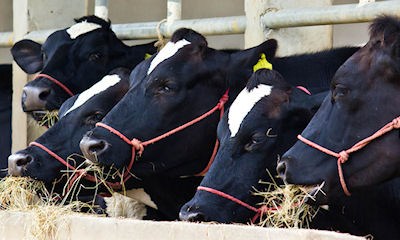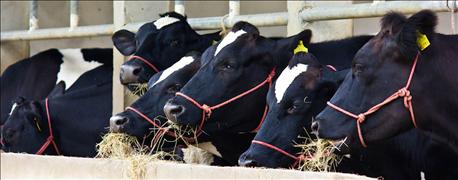
Friday's Land O Lakes new quota shocks eastern milk producers article raises still more questions. Is rising milk production exceeding processing plant capacity in the Midwest and Northeast? Is it setting the stage for more quotas and milk dumping?
Here's a quick response from Andy Novakovic, ag economist and director of engagement at Cornell University's Dyson School of Applied Economics and Management:
This is a tricky question. One needs to balance 1) plant demand and plant capacity, 2) consumer demand in the region, 3) opportunities to sell outside the region, and 4) competition for sales from outside suppliers.

DUMP MY MILK?! Co-ops, caught between member price pressure and lack of balancing plant capacity, turn to quotas or short-term dumping.
Plant demand is obviously mostly motivated by Northeast sales opportunities. But most certainly, that's not the end of it. Consumer demand isn't the same as plant demand on a regional basis.
At this point, I don't have any hard numbers on the volumes of dumped or distressed milk. Dumped is dumped. Distressed would be milk that can only be sold for a price less than the class minimum. Only a cooperative can do that legally.
Federal Order administrators have quite a bit of information about this. But they don't necessarily have a complete accounting. Generally, milk has to be received at a plant for the FO to record it. But there are conditions where dumped milk could be recorded by the FO market administrator.
Dumping is "plan b" routine
Milk has been rather routinely dumped this year throughout the Northeast and Upper Midwest. In the Midwest, consider the region from Michigan in the east and South Dakota in the west and down to the I-states. Dumping occurs on weekends and holidays when we typically are hard pressed to find balancing plants.
Only Wisconsin seems to have sufficient capacity to handle milk every day. In my opinion, this is reflecting supply, demand and cooperative investment strategy. Obviously, the unusually high profits of 2014 and, for the most part, excellent crops, created great conditions for milk production almost everywhere in the United States.
~~~PAGE_BREAK_HERE~~~
In 2014, milk production was strong elsewhere in the world. Worldwide demand didn't match production growth.
U.S. demand tends to trend at a predictable, modest pace. Fluid milk sales have been tanking, which of course doesn't help on either the quantity or price side. But, total U.S. use continues its steady rise.
The bigger challenge has been export markets, where the U.S. is challenged on two fronts. Worldwide growth has slowed as economic growth has slowed, especially in emerging market countries. And, our strong U.S. dollar makes us less competitive versus other suppliers.
We could grab more sales if we discounted the price. Obviously, that has a down side.
These conditions basically give cooperatives, who bear the burden of market balancing, a choice between selling milk at a lower cost to make it go away or maintaining a more favorable price for most milk and dumping the margin that can't find a home at that price. Co-ops have been choosing "plan b".
Co-op balancing act
Simple plant capacity in certain regions [south central Pennsylvania, for example] is a contributing factor. But, that, too, is a reflection of cooperative strategy.
Which is worse, dumping the occasional load of milk or having a balancing plant sit idle or under-utilized for 200 days a year? Coops get pilloried by their members for not returning as high a price as a private processor. So, they've been reluctant to invest in balancing facilities that have market-wide benefits but don't enjoy investment support by all members of the market. It's a kind of no-win situation.
It's a sure bet that there's sufficient total U.S. physical capacity to process all of our milk. But part of the challenge is having enough tanks, trucks and drivers to send milk 500 or 1,000 miles to an open plant. That drive takes a tank out of local use for two to four days, essentially reducing local transportation capacity. And, that creates a different kind of capacity problem.
~~~PAGE_BREAK_HERE~~~
The bottom line is . . .
The fact that we have excess supply throughout much of prime U.S. dairy country is evidence an economist would use to say well, yeah, duh, the price is obviously too high. As the description above indicates, this simple economic conclusion doesn't negate business strategies that are trying to balance a complex and dynamic system. The simple answer may be a bit too simple. If we didn't have regulated pricing, we'd have seen prices declining even more as plants dealt with more milk than they could move at prevailing prices.
If Northeast prices were lower, we'd no doubt produce a bit less milk and demand a bit more. But I'm not sure this simple economic math necessarily means we should conclude that Northeast farm prices are "too high."
The primary driver of regional milk values is how much one has to pay to get milk or dairy products from another region to serve Northeast demand that we can't supply from local milk. My group has done research repeatedly over the years that tends to suggest our regional prices are a bit higher than can be justified by underlying market economics and transportation.
However, I'd be reluctant to extrapolate that to an explanation of current conditions – more a short-term phenomenon than a clear long-term condition. Remember, most of the Upper Midwest also faces occasional dumping conditions.
The apparent lack of physical capacity is mostly a reflection of changing attitudes about producer financing of plant capacity.
If Dairy Farmers of America had built a balancing plant in the Northeast, for example, the news story peg would be "DFA members' dissatisfaction with their net returns," not milk dumping.
About the Author(s)
You May Also Like




